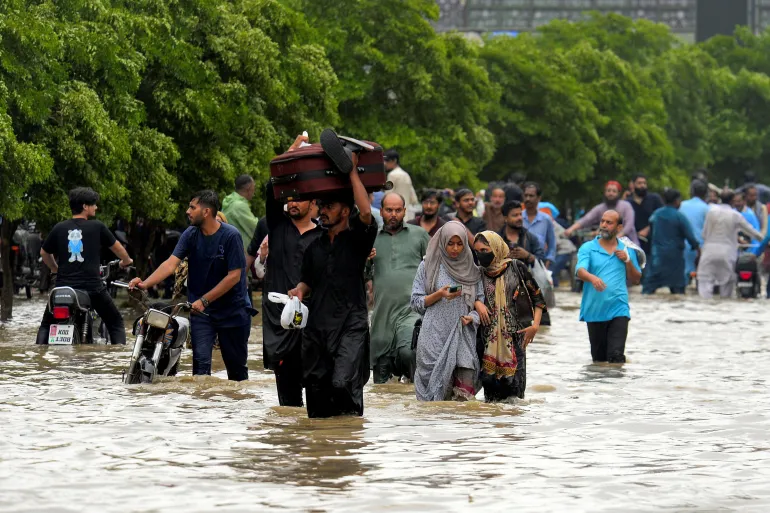

Pakistan is facing severe challenges every year due to climate change. Although Pakistan contributes less than 1% to global greenhouse gas emissions, it is among the most vulnerable countries to the consequences of global warming. Rising temperatures, erratic weather patterns, and excessive monsoon rains have made floods and landslides more frequent and destructive.
Causes of Flooding in Pakistan
- Climate Change Impact
Melting glaciers in the north, coupled with unpredictable rainfall, are adding massive water volumes to rivers. This sudden increase overwhelms Pakistan’s limited water management system. - Excess Water Release from India
Under the Indus Waters Treaty, India often releases millions of cusecs of water into Pakistan’s rivers during peak monsoon season. This sudden influx not only causes heavy flooding but also damages lives, crops, livestock, homes, and infrastructure. - Poor Infrastructure and Planning
Weak embankments, unplanned urbanization, and outdated canal systems worsen the flood impact. Bridges, roads, and railway lines collapse, resulting in billions of dollars in losses every year.
Consequences of Flooding
- Loss of human lives and displacement
- Destruction of houses and property
- Loss of livestock and crops
- Damage to infrastructure (roads, bridges, schools, hospitals, railways)
- Economic loss worth billions of dollars
Solutions and Way Forward
- Construction of New Dams
Pakistan must prioritize building large and small dams to store floodwater. This will not only prevent destruction but also provide water for drinking, cultivation, and irrigation. - Expansion of Canal Systems
Developing new canal networks in Punjab and Sindh plains can divert and store excess water, ensuring its efficient use instead of letting it go to waste. - Learning from Global Models
Countries like the Netherlands, once prone to severe flooding, successfully developed a comprehensive flood management system. Pakistan should study and adapt these best practices. - Climate Adaptation Policies
Stronger policies are needed for sustainable urban planning, glacier monitoring, and community awareness about disaster preparedness. - Urgent National Action
Flood management must be treated as a national priority. Delays will only increase destruction, displace more communities, and worsen Pakistan’s economic burden.
The Netherlands Model: A Global Benchmark
- The Delta Works is an engineering marvel: a series of dams, levees, sluices, storm surge barriers, and locks built between 1954 and 1997 in the Rhine–Meuse–Scheldt delta. It stands as one of the Seven Wonders of the Modern World designated by the American Society of Civil Engineers. Wikipedia.
- Dutch water expertise also includes the “Room for the River” initiative, which increases river capacity through natural flood zones. This has helped manage high water levels without catastrophic flooding. Reddit
Netherlands–Pakistan Cooperation: Still in Development
- Since the devastating floods of 2022, Pakistan has invited Dutch experts to provide technical assistance. Workshops and meetings have taken place in collaboration with ministries like the Ministry of Water Resources and the Climate Change Ministry. Netherlands and youThe Express Tribune+1Business RecorderMinistry of Information and Broadcasting
- Meetings between Pakistani officials (like Minister Sherry Rehman) and Dutch DRR (Disaster Risk Reduction) teams have focused on integrated strategies—early warning systems, floodplain mapping, forecasting, spatial planning, and combining “soft and hard” flood defences. The Express TribuneBusiness RecorderThe News International
- The Netherlands also shared expertise immediately after the 2022 floods, prompting a push for long-term cooperation in water governance. Netherlands and youNewswire
On-the-Ground Projects in Pakistan
- One notable locally adaptive project, supported by the Netherlands Enterprise Agency, is the modernization of spate irrigation systems in Balochistan (Bhag Narri) and Sindh (Nai Gaj). It aims to equitably use floodwater for agriculture and improve resilience—covering some 130,000 hectares. Project Database
- However, these are still pilot-level or regional initiatives—not yet widespread national infrastructure improvements.
✅ Conclusion
Pakistan is not the main cause of global warming, yet it is paying the heaviest price. With collective will, modern infrastructure, and urgent planning, Pakistan can convert the challenge of floods into an opportunity for water storage and sustainable development. The time to act is now — before it is too late.
